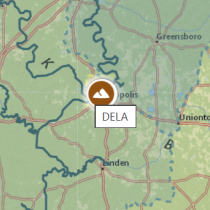Constructing the NEON user facility to support projects large and small
February 13, 2012
In just under four months, civil construction will begin at the first NEON site. The timing couldn’t be better. Ecosystems are increasingly stressed by climate, movement of invasive species over long distances, transport of pollution in the atmosphere, and human land use decisions. Analyzing these large-scale, complicated phenomena requires measuring or manipulating stresses and measuring biological responses in more complex, more expensive programs. NEON is being constructed in response to these growing challenges of multiple stresses and multiple scales in ecosystem science. Such challenges can be addressed by large, integrated projects and well-funded teams, but NEON provides another model. NEON is often considered a “big science” project. In fact, it is a large user facility that supports individual PIs and students, as well as small and large teams equally! http://youtu.be/Ig4JcNpqLmI
Dave Schimel explains how large facilities like NEON differ from large multi-investigator projects, and how various types of users can utilize data and resources from NEON and other sources.
Science user facilities provide resources that can be efficiently shared over many investigators and educators, or are too costly for individuals or institutions to maintain. Such facilities also make state-of-the-science capabilities accessible to a wide range of users. As a user facility, NEON provides free and openly available data and a variety of other resources for use by the public:
- Data over space and time.
NEON data are focused on multiple stresses (climate, land use and invasive species) and on many key responses at the ecosystem and species level. Individual researchers and small teams can simply use these data, or embed targeted studies in this large information base and make use of NEON observations of drivers of change. For example, a researcher or group of researchers interested in the spread of invasives across a specific landscape can request the NEON airborne remote sensing system be deployed to their study area, and gain access to a multi-million dollar, state-of-the-art system. - Project management.
On even larger scales and longer terms, scientists can request relocatable deployments to address emerging, important questions with the NEON facility providing the wide range of disciplines needed to implement such observations as well as covering the sustained costs and labor to maintain quality data over years to decades. This relieves a PI from the common dilemma of choosing between devoting themselves to maintaining a study and spending much of their time on fundraising and logistics. Instead, these functions are carried out by expert professionals, and the PI need only analyze the data that results. - State of the art infrastructure.
The scale, duration and ambition of individual or team projects can be greatly increased by access to a user facility. The PI or his/her institution need not own and maintain costly equipment or maintain costly facilities in the field. Instead, by sharing the user facility, researchers gain as much access to that capability as needed and for as long as needed. Access to state-of-the-art capability also levels the playing field between large, well-funded institutions, and smaller institutions without resources to provide large start-up packages. - Advancing educational resources and broadening participation.
User facilities can greatly increase the diversity of scientists doing world-class ecological science. User facilities enable PIs at undergraduate institutions to conduct world class research, and they are available to researchers at HBCU institutions and EPSCOR states. Facilities also allow young scientists to gain experience with world-class data and instrumentation that was not part of their training. This model works in other fields such as oceanography and astronomy, where primarily undergraduate institution faculty are often leaders in their disciplines.
While scientists often focus on the cost of facilities, the scientists who integrate NEON into their research gain access to capability far more costly than typically covered in research projects. This expanded access to research capability has the potential to greatly increase the diversity of the field and expand the number of people who can contribute. As ecologists seriously begin to address ecology at the continental scale, the comprehensive data, spatial extent and remote sensing technology will allow a large and diverse user community to tackle new questions at scales not accessible to previous generations of ecologists. And so, with not a moment to spare, let the building begin.
